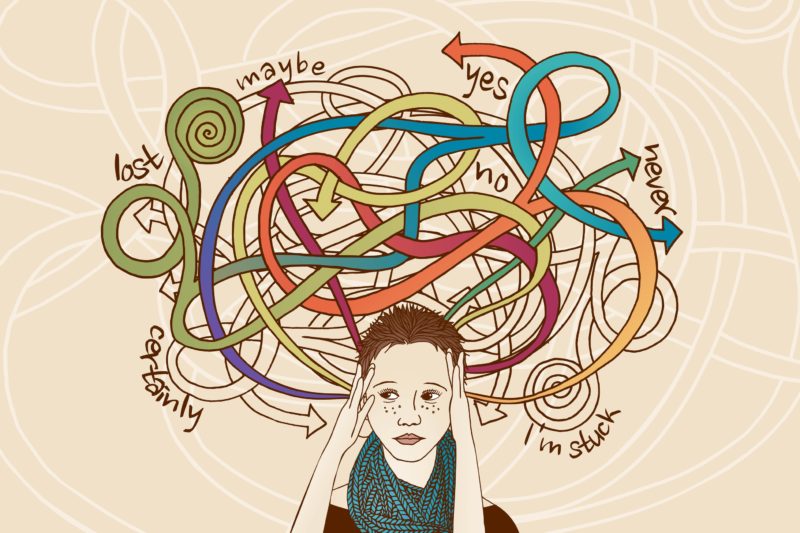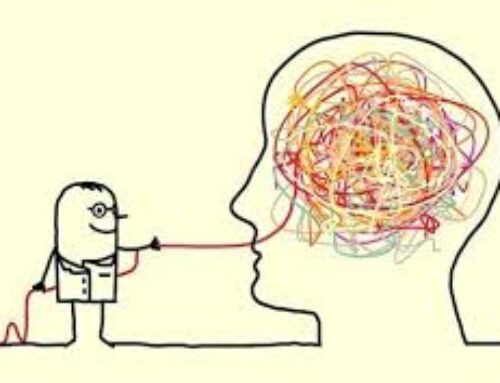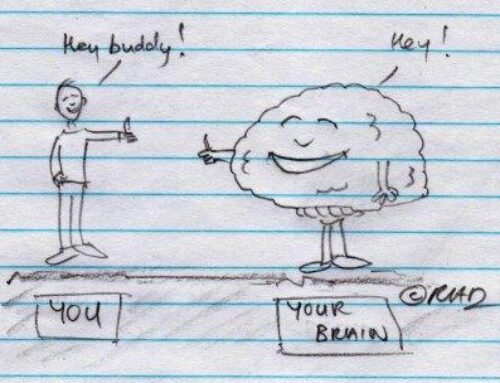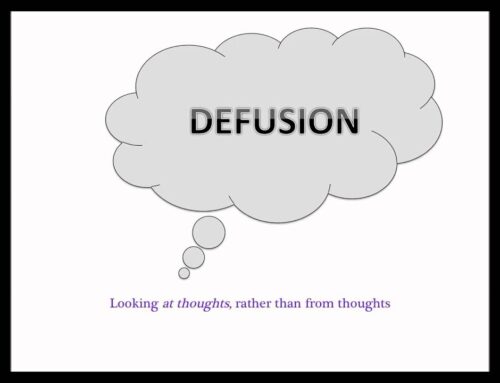1 Quick Exercise to Separate From Painful Thoughts
January 19, 2020
Categories: Thoughts
Painful thoughts can be challenging to work through. Often, we experience a painful thought or story about ourselves, and we believe it to be literally true. For example, we might think “I’m so stupid”, or “I’m never going to amount to anything.” Thoughts don’t come out of nowhere—usually our thoughts are based in previous experiences. This is why they feel real to us. For example, we might have struggled in school or had a learning disability, leading us to think we are stupid. Or, we might have been physically or emotionally abused growing up, leading us to think we won’t amount to anything.
The Problem with Painful Thoughts
The problem with thoughts like these is we can get in a rut, and the thoughts can rigidly impact our future. This can lead us down a path that isn’t in our best interests. For example, if we think we are stupid, we might not pursue going to more school, even though getting our degree would help us get a job we would find meaningful. If we think we aren’t going to amount to anything, we might not put ourselves out there in the world, try to work on ourselves, or develop relationships.
Treating Thoughts as “Just Thoughts”
Sometimes it can be helpful to think about thoughts as “just thoughts.” Our mind is always spinning, always using language to create stories about ourselves, others, and our world. This doesn’t necessarily mean our thoughts are correct, or our stories will definitely come true. Our thoughts don’t actually “do anything” in the literal sense. We still choose our actions and behaviors.
The Chair Exercise
Would you be willing to do a short exercise with me? (It will take less than 5 minutes.)
Start by sitting down in a chair. Take a few deep breaths and get comfortable sitting down in the chair. Now, I’d like you to think the following thought: “I’m stuck—I can’t get up from the chair.”
Keep thinking that thought over and over again for 2 minutes:
I’m stuck—I can’t get up from the chair. I’m stuck—I can’t get up from the chair. I’m stuck—I can’t get up from the chair. I’m stuck—I can’t get up from the chair. I’m stuck—I can’t get up from the chair. I’m stuck—I can’t get up from the chair. I’m stuck—I can’t get up from the chair. I’m stuck—I can’t get up from the chair. I’m stuck—I can’t get up from the chair. I’m stuck—I can’t get up from the chair. I’m stuck—I can’t get up from the chair. I’m stuck—I can’t get up from the chair. I’m stuck—I can’t get up from the chair. I’m stuck—I can’t get up from the chair. I’m stuck—I can’t get up from the chair. I’m stuck—I can’t get up from the chair. I’m stuck—I can’t get up from the chair. I’m stuck—I can’t get up from the chair. I’m stuck—I can’t get up from the chair. I’m stuck—I can’t get up from the chair. I’m stuck—I can’t get up from the chair. I’m stuck—I can’t get up from the chair. I’m stuck—I can’t get up from the chair. I’m stuck—I can’t get up from the chair. I’m stuck—I can’t get up from the chair. I’m stuck—I can’t get up from the chair. I’m stuck—I can’t get up from the chair. I’m stuck—I can’t get up from the chair. I’m stuck—I can’t get up from the chair. I’m stuck—I can’t get up from the chair. I’m stuck—I can’t get up from the chair. I’m stuck—I can’t get up from the chair. I’m stuck—I can’t get up from the chair. I’m stuck—I can’t get up from the chair. I’m stuck—I can’t get up from the chair. I’m stuck—I can’t get up from the chair. I’m stuck—I can’t get up from the chair. I’m stuck—I can’t get up from the chair. I’m stuck—I can’t get up from the chair. I’m stuck—I can’t get up from the chair. I’m stuck—I can’t get up from the chair. I’m stuck—I can’t get up from the chair. I’m stuck—I can’t get up from the chair. I’m stuck—I can’t get up from the chair. I’m stuck—I can’t get up from the chair. I’m stuck—I can’t get up from the chair. I’m stuck—I can’t get up from the chair. I’m stuck—I can’t get up from the chair. I’m stuck—I can’t get up from the chair. I’m stuck—I can’t get up from the chair. I’m stuck—I can’t get up from the chair. I’m stuck—I can’t get up from the chair. I’m stuck—I can’t get up from the chair. I’m stuck—I can’t get up from the chair.
Now, keep thinking the thought “I’m stuck—I can’t get up from the chair” AND at the same time, stand up.
Notice what just happened there. Your mind was saying one thing. But you did the opposite. How is that possible?
Our Thoughts DO NOT Control Our Actions
The answer is our mind and thoughts don’t literally control our actions and behaviors. We can think “I’m stuck—I can’t get up from the chair” AND do the exact opposite behavior.
Now this is a silly example about sitting in a chair, but the same principle can apply to your other, more painful thoughts. For example…
- You can have the thought “I’m so depressed—I can’t get out of bed” AND get out of bed and start your day.
- You can have the thought “I’m so anxious—I could never ask that girl for her phone number” AND walk over to the girl and introduce yourself.
- You can have the thought “I’m so fat and out of shape—this is never going to change” AND attend a class at the gym.
These examples are more difficult because they likely involve emotions, painful experiences, and our histories. But the basic principle still applies. These painful thoughts don’t actually control our actions and behaviors. We can experience these thoughts AND engage in behaviors that are consistent with our values.
Discussion
What was your experience of the chair exercise? How did it feel to think one thing in your head but do something different with your body? How might you apply this principle to a painful thought you are struggling with today?

Related Thoughts

Subscribe To My Newsletter
Join my mailing list to receive the latest blog posts.
Receive my e-book “The Mental Health Toolkit” for free when you subscribe.





